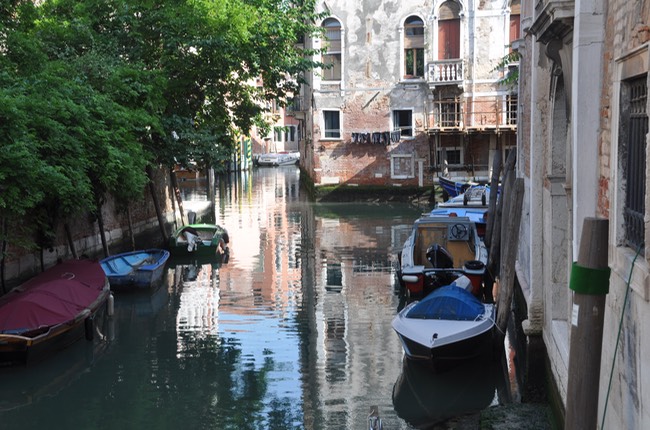Six-thirty a.m. on the Rio del Gafaro, a small canal that marks the boundary between Santa Croce and Dorsoduro. The canal is as still as glass, and only the occasional person passes by, their footsteps echoing along the fondamenta. Two women arrive to open up the café, bringing out tables and chairs. Where the canal intersects with the Rio dei Tolentini, boats can be seen passing, but none are yet coming this way. Boat horns honk in the distance, and occasional voices ring out. These sounds only momentarily break a stillness that is profound. Young men come out with long-handled, whisk-like brooms, to sweep the sidewalks.
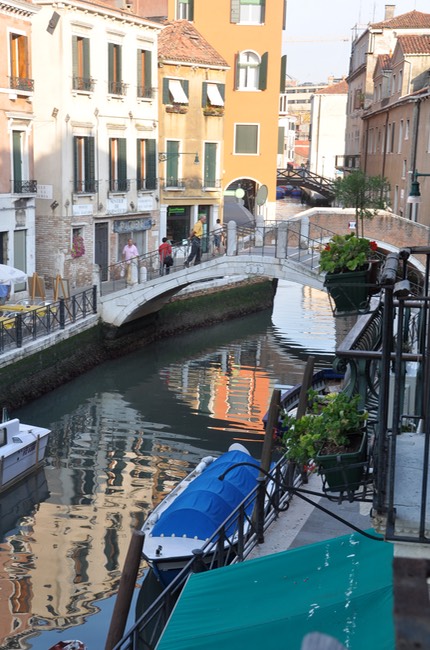
Around eight o’clock, the bells begin to ring from the nearby churches. Venezia contains an incredible number of churches in a relatively small area, and when the bells begin to ring, always one or two at first, with others joining in, as all the clocks are set slightly differently, it creates a magical reverberation of music from all directions. After several minutes of glorious chiming, they gradually fade away, but the early morning stillness is definitely over. Now the sounds of voices and footsteps, boats, and wagons clattering over the steps of the bridges, is continual. The day is in full swing.
Breakfast at the little café could be a quick espresso at the bar, but if there is no hurry, we can sit at a canalside table and watch the boats that make their way into the city. One little boat carries a single workman with a wheelbarrow, while a larger boat carries huge sacks of flour, and still another, crates of bottled water. As the sun begins to appear over the tops of the tall buildings opposite, the table becomes too warm for comfort, and breakfast is over.
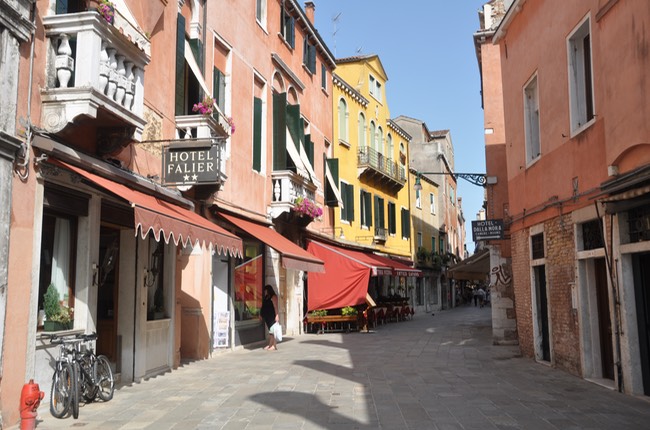
The signs indicating the names of canals and campos, streets and sestieres, are peeling and sometimes almost illegible. Buildings look aged and failing, a shadow of the glorious city-state past. The canals are plied by motor craft of all kinds, from vaporetti to garbage boats, as well as the elegant gondole. And yet, there is a magic about the place.
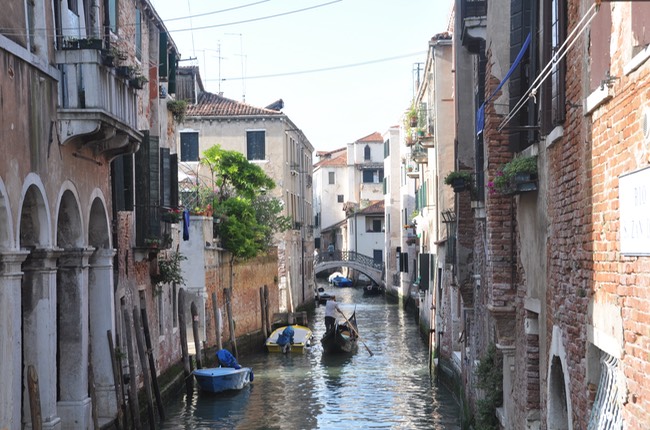
We walked along quiet, narrow streets, where our voices echoed off the stone walls, and we came unexpectedly upon tiny, empty campos and small cafés with tables scattered into the street. We walked into solid, grey churches, entering in from the sunlight into the dim coolness, where the walls and ceilings were painted in gold and covered in art. We crossed over narrow canals by way of small stone bridges, where we might see a gondola appear suddenly from around a bend in the waterway, or hear the gentle humming of an outboard motor as a dinghy made its way beneath us. We travelled down the grand canal by vaporetto, watching the bright sunshine light up the elderly, gracious buildings, and listened to the hum of activity so like, and yet entirely unlike, any other busy street in the world.
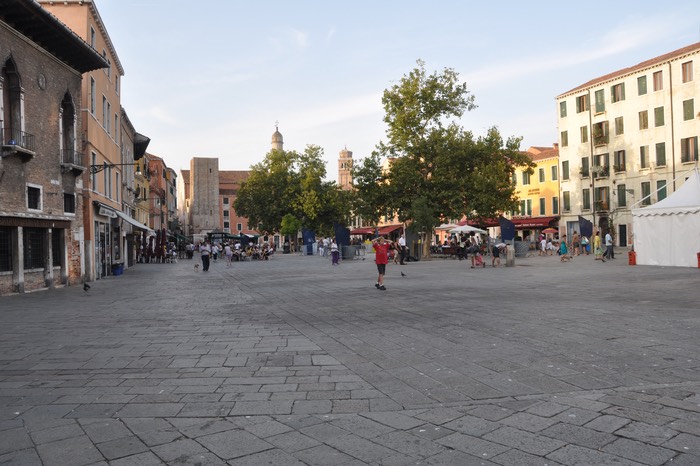
Time and again, we found ourselves returning to the central space of our neighbourhood, the Campo Santa Margherita. It is long and vaguely trapezoidal, with large trees and benches in the centre, and lined with a variety of restaurants and bars, all with ample outdoor seating. There is also the outstanding and popular Pizza al Vole, whose takeaway pizza boxes are found in stacks around the campo’s overflowing trash cans each morning.
We passed through the campo on our way to the vaporetti and traghetti stops of the Grand Canal, stopping at the tiny grocery store for bottled water. We relaxed on the shaded benches, watching the atmosphere change at different times of day. In the morning, people came to shop at the lively fish and produce market, and in the afternoon, they had lunch and congregated in the shade. A pair of elderly ladies, one in a wheelchair, chatted quietly beneath a tree, while some boys kicked a soccer ball hard against the stone wall of one of the buildings– as all the windows are protected by iron grills, there is no worry about breaking glass, and the boys played happily away. In the evening, people filled the restaurants, benches, and steps of the campo, eating, drinking, and listening to live music. On our way home at night, we never failed to stop at Gelato Il Doge, for some of the best (and best-priced) gelato in Venice.
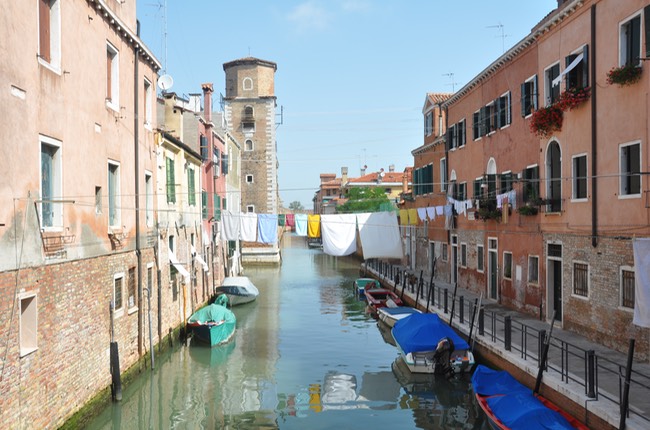
Other than our snacks in Campo Santa Margherita, we did our eating and drinking in the quieter neighbourhoods, away from the sightseeing areas. In the Calle Lunga San Barnaba, we dined in a restaurant that served no seafood, and nothing authentically “Venetian”, but their own culinary twists on Italian cooking with a touch of fusion. It was a wonderful meal, and we could imagine being locals out for a pleasant evening (they can’t eat squid-ink risotto every night!). We enjoyed prosecco and fanta in a small café in the quiet Campo Nazario Sauro, and beer in a shady café on the main thoroughfare of Castello. The Rio di Sant’Anna is lined with lively bars and shops, and a market where produce and fish are sold from both stands and boats. Roads and canals in Castello are wider and straighter, the buildings are less ancient, and the air smells freshly of salt water rather than damp stone.
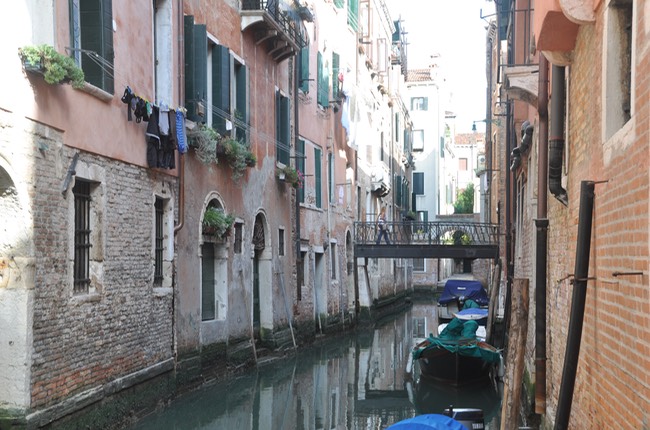
This was our Venezia, replete with beauty and grace, and with a sense not only of history, but of otherworldliness. We experienced vigour, colour, and at times, a calm and profound stillness. We found that it is not necessary to travel back in time to reach La Seremissima, for it is still a part of the Venice of today.
Photos: canal in San Polo; Rio del Gafaro; Salizada San Pantalon; gondolier; Campo Santa Margherita; Rio di Sant' Anna, Castello; San Polo
